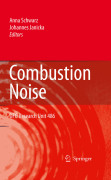
The reduction of noise emissions is a topic of increasing relevance in the public as well as for the economy. So far, the research has mainly concentrated on aerodynamic noise formation by airplanes, as well as other vehicles. The authors of this book go beyond this standard approach for noise reduction and explore the noise generation by combustion. They develop methods and design criteria in order to minimize the noise formation by combustion in general but in particular for aircraft engines in particular. Hereby the research is focused on the noise formation and propagation in the environment directly linked to the combustion process, since today the understanding of these detailed formation mechanisms of combustion noise is still fragmentary. The book gives a detailed insight into combustion noise and the underlying physical processes combining experiments and simulations. Emphasizes the noise formation and propagation originating from the combustion process Combines experiments and numerical simulations INDICE: Numerical URANS.- Swirl Burners with different Burner Exit Geometries.- Large-Eddy Simulation.- the equivalent source method.- Correlation of Entropy Waves and Acoustic Emission in Combustion Chambers.- Influence of boundary conditions on the noise emission of turbulent premixed swirl flames.- Near Field of Premixed and Diffusion Flames.- Wall Noise Interaction and Noise Propagation in Swirled Combustion Chamber Flows.- Direct Numerical Simulation of the interaction between a flame and an acoustic wave.
- ISBN: 978-3-642-02037-7
- Editorial: Springer
- Encuadernacion: Cartoné
- Páginas: 250
- Fecha Publicación: 01/06/2009
- Nº Volúmenes: 1
- Idioma: Inglés
